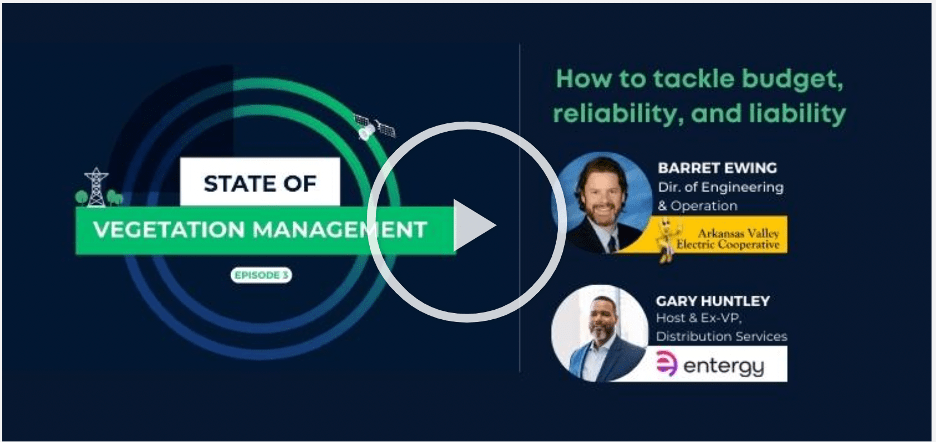Data, and lots of it, boosts efficiencies for Arkansas Valley Electric Cooperative
More than 59,000 metered locations across Western Arkansas and Eastern Oklahoma depend on Arkansas Valley Electric Cooperative Corporation (AVECC) to keep the lights on.
The utility has its work cut out for its staff and contractors, as it must maintain over 6,600 miles of distribution lines and 36 electrical substations, and much of that responsibility falls in rural areas. AVECC is faced with the challenges of ensuring reliability, avoiding outages and events that create liability, and doing it all within budget.
These challenges set the stage for the third episode of our State of Vegetation Management live event series. Host Gary Huntley, former vice president of distribution at Entergy, spoke with Barrett Ewing, director of engineering and operations at Arkansas Valley Electric Cooperative, to take a look at how the utility is working to meet these issues head-on.
View the event here or read on for a few key takeaways from the discussion.
Costs are increasing from all angles and old budget rules don’t apply
Huntley and Ewing agreed that costs are climbing everywhere. Vegetation managers are seeing the increases in equipment, operations, and labor expenses — with budgets remaining stagnant, as usual, and no relief in sight.
“That’s the concerning point now,” said Ewing. “As we look over the next 3 to 5 years, how do we manage, knowing that we’re already having to make cuts?”
The cost factor has prompted Arkansas Valley Electric Cooperative to reach out to vendors they might not have used on the past to “make sure we are getting the best bang for our buck,” he said.
The utility has tried to stabilize cost-per-mile outlays. Standard drive-by or boots-on-the-ground assessments are extremely time-consuming and not fully effective, since you aren’t physically going to be able to look at everything, Ewing explained. So AVECC added drones for oversight of its 6,600 miles of distribution lines. But drones, he noted, are also labor intensive, as evaluating video takes a lot of time.
According to Ewing, today’s cost increases led the utility to ask, “How can we be more efficient with the spending money we’ve got and how do we now move forward … knowing that what we’ve done in the past isn’t sustainable?”
AVECC realized more needed to be done to create cost efficiencies, which led to consideration of data-driven, satellite- and AI-based solutions.
It’s time to rethink calendar-based cycle trims for rights of way
The cooperative utility had a history of being reactive rather than proactive in handling vegetation issues, so almost a decade ago it decided to move to a cycle trim plan with a 6-year rotation. Each year would cover roughly 1,000 or so line miles.
The results?
AVECC saw that some areas may not need to be cut within the rotation assignments while others needed more frequent attention or work done outside of the assignments.
“We’ve just seen a full rotation, but now we’re asking if the 6-year rotation is right,” Ewing explained.
The cycle trim did not do much to ease the time-consuming process of creating maps for contractors to bid on. And while the approach of grouping distribution line miles and substations together in 1,000-mile assignments reduced travel time between locations, it did not prevent the possibility for areas in urgent need of attention to be missed. Throughout the largely rural territory, trim areas also could be inaccurately reported as complete, or trimmed before there is a need.
Data is the future of vegetation management operations
AVECC considered its limited resources and time and recognized that a solution that served up the data when needed, such as management data for work orders and reliability numbers, was in order.
“I think that’s why we’re as excited as we are about adding the AiDash solution — for the ease of data and for efficiencies with the workflow processes,” said Ewing.
It’s these efficiencies that come in handy when trying to work within or cut the budget yet retain reliability numbers.
With right-of-way (ROW) trim the biggest budget item and assurance of reliability, a higher spend is expected there. Unfortunately, Ewing noted, it is also the area most often looked at when cuts are needed. Instead of covering 1000 line-mile ROWs each year, a tightened budget might require the number be reduced.
In this situation, being proactive with the satellite remote sensing data and AI insights makes a difference.
For example, the utility can determine whether its ROWs are in a good enough shape to bring the trim map and budget down to 800 miles for the year. And if so, which 800 miles will be the most effective choice for the trim.
Said Ewing, “I think we’re in that mode of proactivity with AiDash software. We know the software is not going to fix our budget problem completely, but it’ll give us the data we need to look at.”
To learn more about Arkansas Valley Electric Cooperative Corporation’s work to increase reliability and avoid liability on a tight vegetation management budget watch the video here.
Or get more information about AiDash’s Intelligent Vegetation Management System here.
